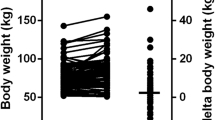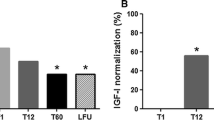Abstract
Background: Acromegaly is known to be associated to vascular damage characterized by an increase of vascular wall thickness and an impairment of vascular function. Aim: The aim of this study was to evaluate the effect of medical treatment with the GH receptor antagonist pegvisomant on vascular structure and function in acromegalic patients resistant to somatostatin analogues. Patients: Ten patients (4 males and 6 females, 28–58 yr) and 20 sex-, age-, and body mass index-matched healthy controls entered the study. All patients were treated for 18 months with pegvisomant at doses ranging from 10 to 40 mg/day. Outcome measures: Primary outcome measures were measurement of carotid arteries intima-media thickness (IMT), and brachial arteries flow mediated dilation (FMD); secondary outcome measures were blood pressure, blood glucose and lipids levels. Results: Carotid arteries maximal IMT was significantly higher in patients than in controls at baseline (1.18±0.59 vs 0.69±0.13, p=0.001) and slightly, but not significantly, decreased after treatment (0.97±0.17). Brachial arteries FMD was significantly lower in patients than controls at baseline (7.5±2.5 vs 13.1±1.4, p<0.001) and significantly increased after treatment (8.8±3.7, p=0.016). Systolic (SBP) and diastolic (DBP) blood pressure values, serum glucose and insulin levels and homeostasis model assessment (HOMA) index were higher, whereas HDL-cholesterol levels were lower in patients than controls at baseline. After treatment, SBP and DBP, as well as serum glucose and insulin levels and HOMA index significantly decreased whereas no significant change was found in serum lipid profile. Conclusions: The results of the current study suggested that long-term treatment with pegvisomant induced a slight reduction of carotid arteries wall thickness and a significant improvement of brachial arteries vascular function in patients with acromegaly resistant to somatostatin analogues.
Similar content being viewed by others
References
Colao A, Ferone D, Marzullo P, Lombardi G. Systemic complications of acromegaly: epidemiology, pathogenesis, and management. Endocr Rev 2004, 25:102–52.
Wright AD, Hill DM, Lowy C, Fraser TR. (1970) Mortality in acromegaly. QJ Med 1970, 39: 1–16.
Colao A, Spiezia S, Cerbone G, et al. Increased arterial intima-media thickness by B-M mode echodoppler ultrasonography in acromegaly. Clin Endocrinol (Oxf) 2001, 54: 515–24.
Otsuki M, Kasayama S, Yamamoto H, et al. (2001) Characterization of premature atherosclerosis of carotid arteries in acromegalic patients. Clin Endocrinol (Oxf) 2001, 54: 791–6.
Chanson P, Megnien JL, del Pino M, et al. Decreased regional blood flow in patients with acromegaly. Clin Endocrinol (Oxf) 1998, 49: 725–31.
Brevetti G, Marzullo P, Silvestro A, et al. Early vascular alterations in acromegaly. J Clin Endocrinol Metab 2002, 87: 3174–9.
Schiavon F, Maffei P, Martini C, et al. Morphologic study of microcirculation in acromegaly by capillaroscopy. J Clin Endocrinol Metab 1999, 84: 3151–5.
Maison P, Démolis P, Young J, Schaison G, Giudicelli JF, Chanson P. Vascular reactivity in acromegalic patients: preliminary evidence for regional endothelial dysfunction and increased sympathetic vasoconstriction. Clin Endocrinol (Oxf) 2000, 53: 445–51.
Colao A, Marzullo P, Cuocolo A, et al. Reversal of acromegalic cardiomyopathy in young but not in middle-aged patients after 12 months of treatment with the depot long-acting somatostatin analogue octreotide. Clin Endocrinol (Oxf) 2003, 58: 169–76.
Colao A, Marzullo P, Lombardi G. Effect of a six-month treatment with lanreotide on cardiovascular risk factors and arterial intima-media thickness in patients with acromegaly. Eur J Endocrinol 2002, 146: 303–9.
Colao A, Pivonello R, Auriemma RS, et al. Efficacy of 12-month treatment with the GH receptor antagonist pegvisomant in patients with acromegaly resistant to long-term, high-dose somatostatin analog treatment: effect on IGF-I levels, tumor mass, hypertension and glucose tolerance. Eur J Endocrinol 2006, 154: 467–77.
Parkinson C, Drake WM, Wieringa G, Yates AP, Besser GM, Trainer PJ. Serum lipoprotein changes following IGF-I normalization using a growth hormone receptor antagonist in acromegaly. Clin Endocrinol (Oxf) 2002, 56: 303–11.
Pivonello R, Galderisi M, Auriemma RS, et al. Treatment with growth hormone receptor antagonist in acromegaly: effect on cardiac structure and performance. J Clin Endocrinol Metab 2007, 92: 476–82.
Sesmilo G, Fairfield WP, Katznelson L, et al. Cardiovascular risk factors in acromegaly before and after normalization of serum IGF-I levels with the GH antagonist pegvisomant. J Clin Endocrinol Metab 2002, 87: 1692–9.
Trainer PJ, Drake WM, Katznelson L, et al. Treatment of acromegaly with the growth hormone-receptor antagonist pegvisomant. N Engl J Med 2000, 342: 1171–7.
van der Lely AJ, Hutson RK, Trainer PJ, et al. Long-term treatment of acromegaly with pegvisomant, a growth hormone receptor antagonist. Lancet 2001, 358: 1754–9.
Giustina A, Barkan A, Casanueva FF, et al. Criteria for cure of acromegaly: a consensus statement. J Clin Endocrinol Metab 2000, 85: 526–9.
Dilley RJ, Schwartz SM. Vascular remodeling in the growth hormone transgenic mouse. Circ Res 1989, 65: 1233–40.
Andersson IJ, Johansson ME, Wickman A, et al. Endothelial dysfunction in growth hormone transgenic mice. Clin Sci (Lond) 2006, 110: 217–25.
Bohlooly YM, Carlson L, Olsson B, et al. Vascular function and blood pressure in GH transgenic mice. Endocrinology 2001, 142: 3317–23.
Sowers JR, Standley PR, Ram JL, Jacober S, Simpson L, Rose K. Hyperinsulinemia, insulin resistance, and hyperglycemia: contributing factors in the pathogenesis of hypertension and atherosclerosis. Am J Hypertens 1993, 6: 260S–70S.
Cohen R, Chanson P, Bruckert E, et al. Effects of octreotide on lipid metabolism in acromegaly. Horm Metab Res 1992, 24: 397–400.
Ho KK, Jenkins AB, Furler SM, Borkman M, Chisholm DJ. Impact of octreotide, a long-acting somatostatin analogue, on glucose tolerance and insulin sensitivity in acromegaly. Clin Endocrinol (Oxf) 1992, 36: 271–9.
Moller N, Schmitz O, Jøorgensen JO, et al. Basal- and insulin-stimulated substrate metabolism in patients with active acromegaly before and after adenomectomy. J Clin Endocrinol Metab 1992, 74:1012–9.
Oscarsson J, Wiklund O, Jakobsson KE, Petruson B, Bengtsson BA. Serum lipoproteins in acromegaly before and 6–15 months after transsphenoidal adenomectomy. Clin Endocrinol (Oxf) 1994, 41: 603–8.
Barkan AL, Burman P, Clemmons DR, et al. Glucose homeostasis and safety in patients with acromegaly converted from long-acting octreotide to pegvisomant. J Clin Endocrinol Metab 2005, 90: 5684–91.
Jørgensen JO, Feldt-Rasmussen U, Frystyk J, et al. Cotreatment of acromegaly with a somatostatin analog and a growth hormone receptor antagonist. J Clin Endocrinol Metab 2005, 90: 5627–31.
Author information
Authors and Affiliations
Corresponding author
Rights and permissions
About this article
Cite this article
De Martino, M.C., Auriemma, R.S., Brevetti, G. et al. The treatment with growth hormone receptor antagonist in acromegaly: Effect on vascular structure and function in patients resistant to somatostatin analogues. J Endocrinol Invest 33, 663–670 (2010). https://doi.org/10.1007/BF03346667
Published:
Issue Date:
DOI: https://doi.org/10.1007/BF03346667




